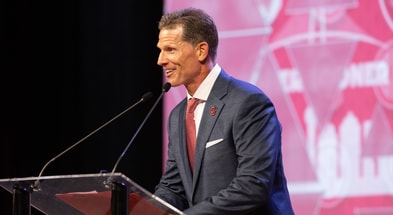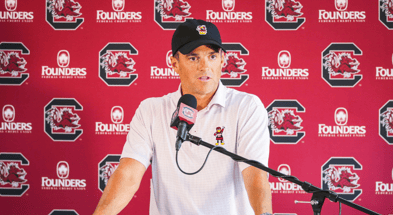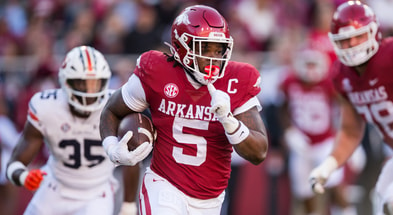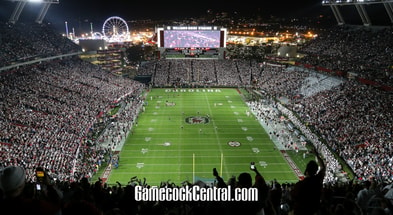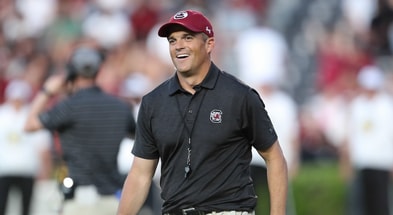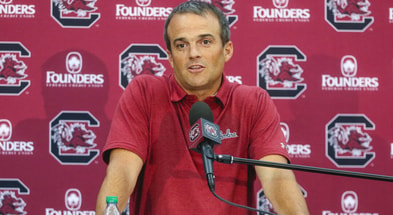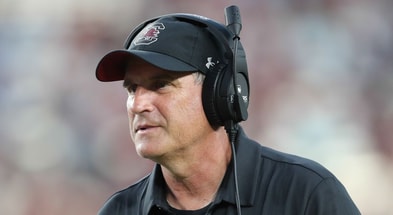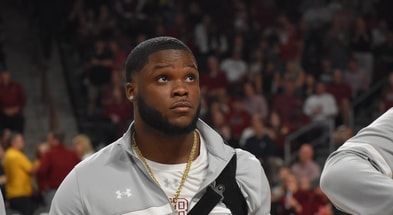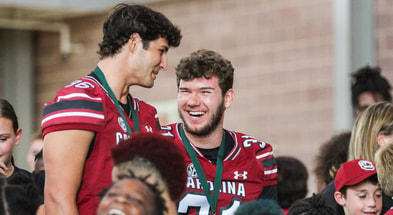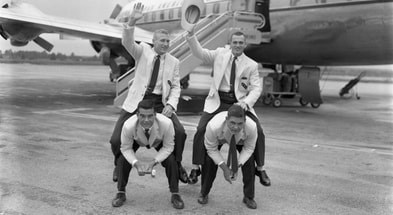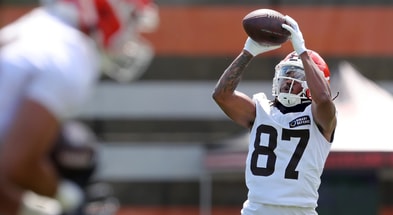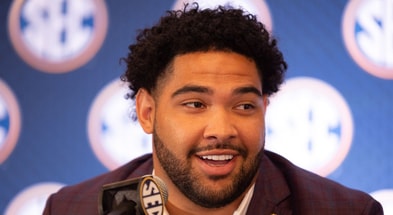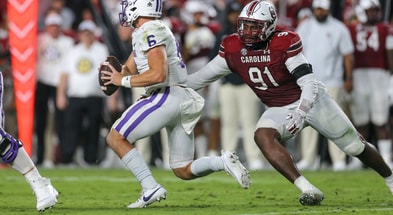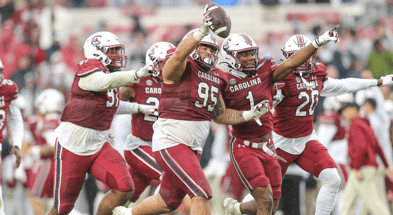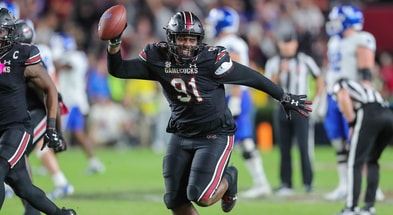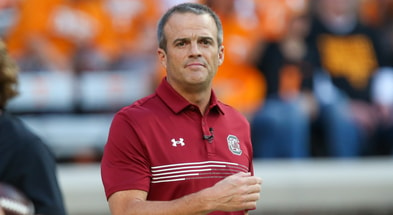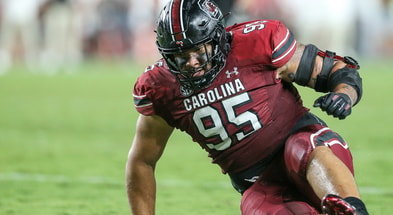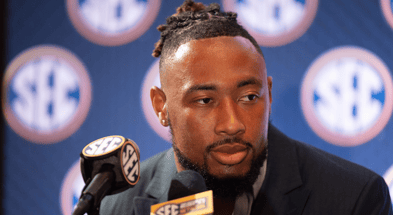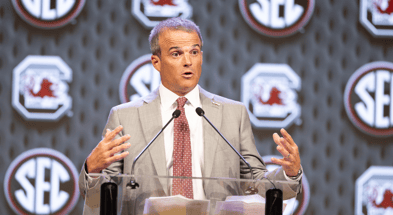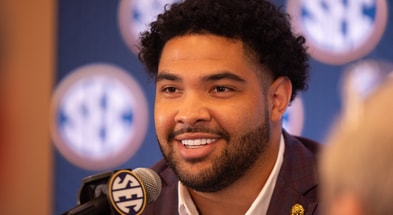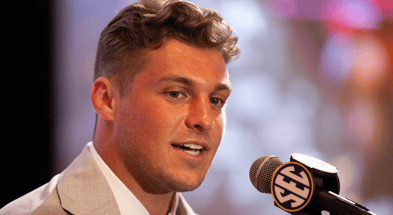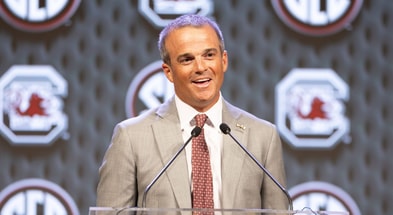A fine christening under heavy skies: Williams-Brice Stadium debuts as Columbia Municipal Stadium
Introducing South by Southeast – A Gamecock History Newsletter! Alan Piercy, a lifelong Gamecock fan and Carolina grad, brings an ongoing series spanning the history of Gamecock athletics, from the SEC, to the Metro/Independent years, to the ACC and beyond. A sepia-toned remembrance of all things Garnet & Black. Alan is the author of the upcoming book, A Gamecock Odyssey: University of South Carolina Sports in the Independent Era (1971-1991), due for release by USC Press in November 2023.
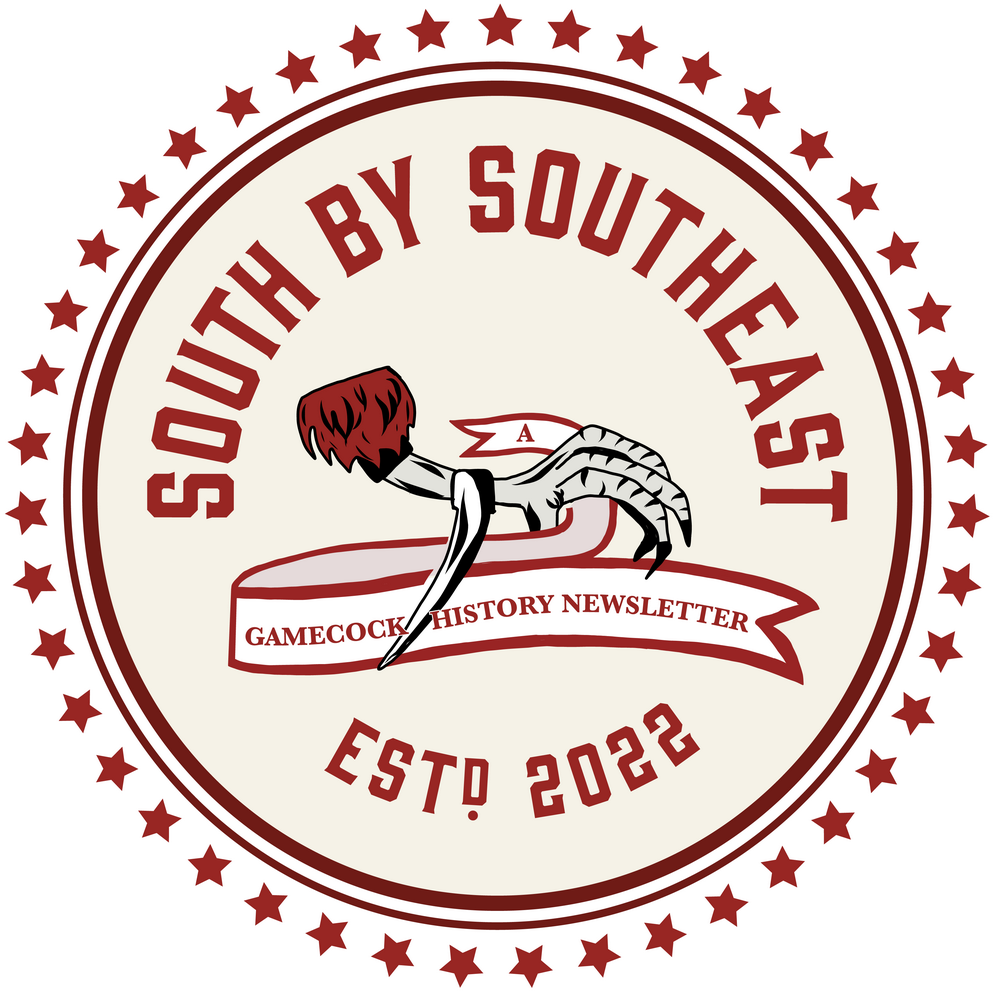
Williams-Brice Stadium debuted as Columbia Municipal Stadium on Oct. 6, 1934
“Performing on a soaked field, under heavy skies that often wept, the Gamecocks played alert football, making and taking the breaks, to beat the Flying Squadron, 22 to 6, while a great crowd, cut short by the weather but formidable at that, forgot the discomforts of the rain, and saw an interesting, clean-cut battle.”– Commentary on the inaugural game at Columbia Municipal Stadium, The State, Oct. 7, 1934
The 1934 season dawned late by modern standards, with the opening game between Carolina’s Gamecocks and the Erskine Flying Fleet taking place in Columbia on Sept. 29. It was the final game at the old wooden grandstands of Melton Field, Carolina’s football home between 1926 and that opening game of ‘34.
“Carolina opens season versus Erskine ‘Seceders,’” a newspaper headline proclaimed, citing an older nickname for Erskine’s athletic teams. A Greenville sports writer, Carter “Scoop” Latimer, commented on Erskine’s passing strategy following a 1929 football game, noting Erskine looked like a “flying fleet,” and the name stuck. The student body soon voted to adopt it as their official nickname, however “Seceders” hung around in the popular lexicon for years after.
Gamecock coach Billy Laval, in his seventh and final season at the helm for Carolina, had guided his program to one of the more successful eras in program history, including a 3-0 Southern Conference ledger in 1933. An article in The State on the morning of that first game noted Carolina had won a share of the conference title in ‘33, however Duke had gone 4-0 and was officially recognized as the conference champs. Notably, Carolina was also riding a rare three-game win streak over their arch-rival Clemson Tigers coming into the 1934 season, and expectations were high in Columbia for continued success.
There was further excitement for the 1934 season because of a sparkling new home stadium set to host Carolina’s second game versus Virginia Military Institute (VMI) a week later. Carolina handily defeated Erskine 25-0 in the opener, and all attention turned to the dedication of new venue.
A series of newspaper articles during the week leading up to the VMI game examined all facets of the new stadium. “New Stadium Eliminates Sun From Players’ Eyes,” proclaimed one. Most on-campus stadiums across the country were shoehorned into relatively small parcels of land, whatever might be available amongst other campus buildings. The size of the lot obtained for Carolina’s new stadium, over twenty acres located approximately two miles south of campus, permitted engineers to locate the playing field in any direction they desired. The northwest-to-southeast orientation of the new field was designed to lessen the effects of sun in players’ eyes.
The framework of the stadium was entirely cladded in steel, painted battleship grey. Seats were comprised of two cypress boards, with spacing eleven inches wide – commodious for Depression-era sports fans, but decidedly tight by the standards of today’s ever-widening populace. Restrooms were located under the stands, along with two dressing rooms, each containing six showers with hot and cold water, luxuries at the time. The north and south ends of the stadium were enclosed by board fences, designed to be temporary in nature, and easily replaceable by additional stands for future expansions.
“Long work by interested people”
Efforts to secure a new stadium for the university were led by George Bell Timmerman Jr. of Batesburg, former president of the Carolina Alumni Association and later Governor of South Carolina between 1955 and 1959. As the Great Depression deepened, President Franklin Delano Roosevelt’s New Deal programs offered a lifeline for municipal projects across the country, providing financing through programs such as the Reconstruction Finance Corporation, and labor through the Works Progress Administration, and other similar programs.
Land for the new stadium was purchased by friends of the university who gave $100 apiece after the owner, Mrs. Thomas Taylor, agreed to sell for a significantly reduced price. The Taylor family had owned vast swaths of land along the Congaree River for generations, including the land which became the planned city of Columbia, when South Carolina’s capitol moved from Charleston to the Midlands in 1786. The stadium property was deeded to the City of Columbia so that bonds could be issued, as the University could not, by matter of law, take on such bonds. The city would deed the stadium to the University by 1935.
Built at a cost of $82,000 (1.8 million in 2023 dollars), the stadium was designed by Columbia architects Lafaye and Lafaye, and engineers Sumwalt and Rowe. The steel contractor was Virginia Bridge & Iron Co, and woodwork was provided by W.A. Crary and Son of Columbia. The stands were built with a crescent shape, designed so that every spectator could see every play from any of the 18,200 seats.
Due to insufficient appropriations, the stadium was built with “efficiency, durability, and capacity as the dominating factors of construction,” according to designers. Eventual upgrades were anticipated to include enclosure of the exposed steelwork visible from the exterior of the stands, with high brick walls arranged as series of archways with high ornamental iron gates. Many of those decorative flourishes would eventually occur, though for the better part of nine decades the stadium maintained a spartan, industrial feel, even through numerous expansions.
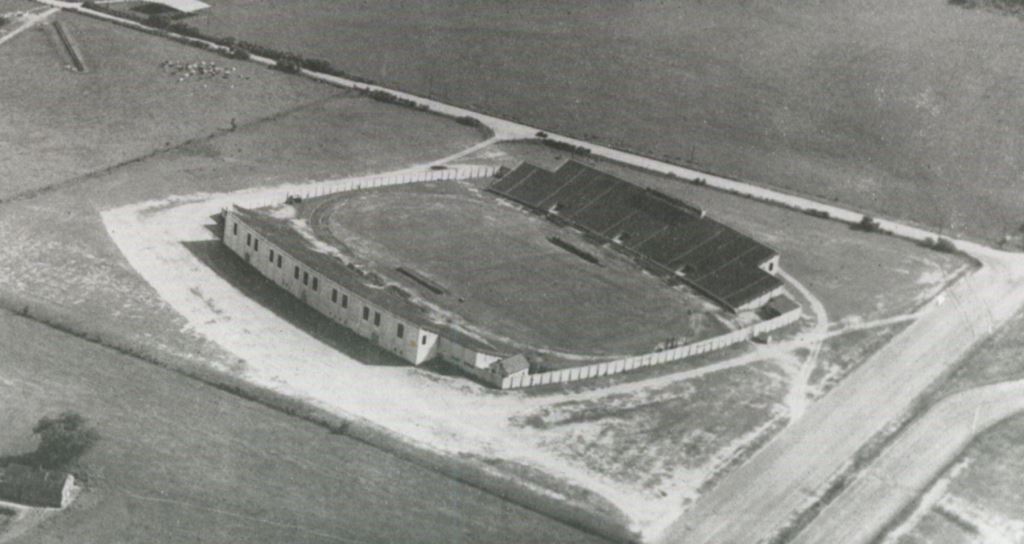
Civic Pride on display
The State noted on the day prior to the VMI game, there would be a continuous round of “delightful and attractive events,” beginning at 3 p.m. on game day, with the game following.
“You can see another game in the stadium later, but there will be only one dedication, only one ‘first game,’ and those who do not join the merry throng for the VMI-Carolina contest will always regret it.”
Saturday, Oct. 6, dawned grey and drizzly with an unpromising forecast for the opening festivities. But, reports noted that the dedication ceremony would carry forth, rain or shine.
By 3 p.m., skies grew darker and a fine rain which had been intermittent all day began to fall more consistently. The rain, according to reports, “in no way dampened the enthusiasm of the crowd present, and the several features of the program were followed with closest interest.” Around 10,000 spectators filed into the stadium, the rain suppressing what would have been a likely sellout in more agreeable weather.
At the appointed time, the various dignitaries and university brass assembled at the north end of the field. The Columbia High School band marched in their white uniforms down the gridiron, followed close behind by the Carolina band in its garnet, black and white regalia. Next came the American Legion drum and bugle corps in their blue and gold finery, sporting chrome helmets, followed by distinguished guests, including South Carolina Governor Ibra C. Blackwood, Governor-elect Olin D. Johnston, and Columbia Mayor L.B. Owens, among others.
The vaguely militaristic sounds of battle drum and bugle heralded the dedication ceremony as the high school band went to one side of the flag pole, the Carolina band to the other, while the drum corps split ranks to let the distinguished guests walk through, along with “nine lovely girls” who each took a part in the christening ceremony, all carrying handsome bouquets of dahlias arranged in the colors of the University of South Carolina, and of the Virginia Military Institute. The Carolina band played the alma mater, and everyone stood, umbrellas dotting the stands.
Timmerman rose for his dedication speech.
“For years while I was president of the alumni association, I entertained the hope that the university would have a stadium for its athletic activities comparable with those enjoyed by its peers, and in keeping with its surroundings, its dignity and importance.
“Today I am happy to witness a partial realization of that hope. At this time I deem it fitting, on behalf of the university and its alumni, to say that every contribution made to the success of this occasion, from whatever source it may have come, is deeply appreciated. I cannot mention all who have generously aided the movement. However, I would point out that without the splendid cooperation given by the friends and alumni of the university, and especially the good people of Columbia, acting individually and through the media of their chamber of commerce and city council, this fine thing which we witness today – the dedication of the stadium – would not have happened.
“Mr. Mayor, speaking for the stadium committee and all whom they represent, it is my duty and pleasure to present and commit to your keeping, as the chief magistrate of our beloved Capital City – the home of the university – this beautiful stadium, which represents in a fine way the spirit of progress and optimism so characteristic of this state and community.”
Mayor Owens rose next, and after brief remarks of acceptance, hoisted Old Glory to the top of the flag pole, “which caught in a breeze and was thrown out to full length.” As the flag ascended, the Carolina band played the Star Spangled Banner and at it’s conclusion, a young coed, Ms. Wooding of Victoria, Virginia, dashed a bottle of champagne against the flag pole in a great celebratory spray. And at that, the ceremony concluded.
Hardly had the field been cleared, when the low drone of an airplane was heard, and from out of the clouds came P.P. Parish, Jr, operator of the Parish Flying Service at nearby Owens Field. He circled the field, flew north over Columbia, then doubled back, flying low over the stadium and dropped from his plane a football carrying the colors of USC and VMI. The ball fell, according to reports, near the center of the field, as the plane banked and swooped back over the stands. A goggled and leather helmeted Parish, admiring the accuracy of his toss, gave a snappy wave, his scarf flapping behind him from the open cockpit, and promptly disappeared among the low clouds.
A few moments later, the whistles blew and the game was on in the new municipal stadium, “the realization of a dream long entertained by lovers of sports.”
Carolina won that first game convincingly, 22-6, over the visitors to move to 2-0 on the season. Scoring was highlighted by a blocked VMI kick by right end Bob Johnson which was recovered in the end zone for a touchdown by left end John Rowland.
The Gamecocks went 2-2 at their new home that season, beating Virginia Tech and losing to both Clemson and William and Mary en route to a 5-4 season (2-3 SoCon).
But beyond the wins and losses of that inaugural season, Columbia Municipal Stadium marked a triumph of partnership between a city and a university. It stands as a monument to the civic-minded men and women who, even while toiling under the burdens of unprecedented economic strife, chose to engage in the hard work of collective problem solving, of visionary action over the pettiness of political gridlock, and of optimism over fear.
Old stadiums, as it turns out, hold lessons for us all.
